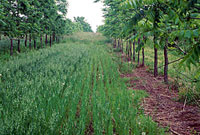
Tropical forest gardening
 One of my favorite parts of Forest
Gardening
was its in depth description of several tropical forest gardens.
In locations as diverse as India, Indonesia, Sri Lanka, Tanzania,
Nigeria, Central America, and the Amazon, people have been creating
forest gardens for at least a thousand years.
One of my favorite parts of Forest
Gardening
was its in depth description of several tropical forest gardens.
In locations as diverse as India, Indonesia, Sri Lanka, Tanzania,
Nigeria, Central America, and the Amazon, people have been creating
forest gardens for at least a thousand years.
I've described Central
American forest gardens and Amazonian
forest gardens in the past, and
all of the tropical forest gardens seem to be pretty similar.
These forest gardens are usually small --- less than two acres in size
--- and are located around the farmers' homesteads where they serve as
a kitchen garden. The many-layered forest includes fruit and nut
trees as well as plants that produce timber, fuel, medicines, and other
products. In many cases, some of the trees are cash crops ---
coffee, cinnamon, and nutmeg in Sumatra, bananas and coffee in Tanzania.
Most forest garden owners had plots out in the open where they planted
cereals and other sun-loving vegetables to supplement their forest
garden food.
 Forest gardens are often
in mountainous areas where tilling the soil would lead to erosion and
soil loss. In fact, a more modern incarnation of forest gardening
was developed specifically for this erosion-reducing purpose. In
the 1970s and 80s in Nigeria, B.T. Kang developed a system called alley
cropping that consisted of growing cereals and vegetables in strips
between leguminous trees on hillsides. The trees prevented
erosion and fertilized the crops by fixing nitrogen. The trees
were also pruned heavily, with the cut branches used as mulch in the
annual garden and as garden stakes, firewood, and fodder.
Forest gardens are often
in mountainous areas where tilling the soil would lead to erosion and
soil loss. In fact, a more modern incarnation of forest gardening
was developed specifically for this erosion-reducing purpose. In
the 1970s and 80s in Nigeria, B.T. Kang developed a system called alley
cropping that consisted of growing cereals and vegetables in strips
between leguminous trees on hillsides. The trees prevented
erosion and fertilized the crops by fixing nitrogen. The trees
were also pruned heavily, with the cut branches used as mulch in the
annual garden and as garden stakes, firewood, and fodder.
Why was forest gardening
so widespread in the tropics but not in temperate regions? The
fact is that many useful tropical plants will fruit in the semi-shaded
understory, while most temperate fruits need full sun to grow. In
addition, the light in the tropics is intense enough to enable tropical
forest gardeners to grow traditional vegetables like beans, tomatoes,
and corn in the understory of an open forest, another element that
won't work here. Developing a temperate forest gardening system
was the challenge that Robert Hart and later pioneers faced.
| This post is part of our Robert Hart's Forest Gardening lunchtime
series.
Read all of the entries: |
Want more in-depth information? Browse through our books.
Or explore more posts by date or by subject.
About us: Anna Hess and Mark Hamilton spent over a decade living self-sufficiently in the mountains of Virginia before moving north to start over from scratch in the foothills of Ohio. They've experimented with permaculture, no-till gardening, trailersteading, home-based microbusinesses and much more, writing about their adventures in both blogs and books.
Want to be notified when new comments are posted on this page? Click on the RSS button after you add a comment to subscribe to the comment feed, or simply check the box beside "email replies to me" while writing your comment.
- Remove comment

- Remove comment
